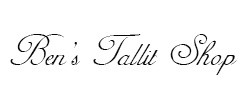Among many traditional Sephardic Jews, the prevalent custom is to wear a white-on-white tallit, but many other Jews also choose a solid white tallit with white stripes for aesthetic reasons, sometimes as a Shabbat tallit, a special tallit for Rosh Hashana and Yom Kippur or a wedding tallit to be worn at the chuppah.
The Kaf Hachaim (9:15) cites various reasons why the tallit itself should be white, adding that black stripes do not invalidate this, since we consider the majority of the tallit.
One of the reasons he mentions is that the Shulchan Aruch says the tzitzit should be the same color as the garment; since the strings are white, the tallit should be white as well.
The Gemara (Rosh Hashanah 17b) says G-d wore a tallit when telling Moshe the 13 Attributes of Mercy. G-d then told Moshe if the Jews do as I have done they will be forgiven. In Daniel 7:9 we find, “I was looking until thrones were set up, and the Ancient of Days sat; His raiment was as white as snow,” which shows G-d wears (so to speak) a white tallit.
White Tallit Options
Recently I received the following question from a customer in Los Angeles:
I want a size 70 white tallit made of wool, to be used at our upcoming wedding and then on high holidays. I cannot decide between the Prima, the Tashbetz, the Beit Yosef, Chatanim or Hamefoar. They all look similar to me. I need help identifying the differences to make a selection. Can you please help me?
Let me try to shed some light on the scene.
The Prima A.A. Tallit is the standard white tallit. It’s a good quality weave, but has no special features. The stripes are satiny.
The Hamefoar White Tallit has a denser weave, stiffened corners (to keep the tzitzit from sliding around), the corner reinforcements are made of wool, which is slightly superior from a halachic standpoint, and the fabric is designed to resist stains and stay white for many years. It has a different weave that’s softer, more pliant, a bit puffy on the shoulders, and it tends to stay in place a better.
The Tashbetz Tallit is similar, but lighter in weight and it doesn’t have wool corner reinforcements. If you hover on the image you should be able to discern the waffle-like pattern of the weave.
The Beit Yosef Tallit stands apart. It is made entirely of wool, including the corners and the atara (neckband), and the striping is not satiny, but very subtle. Because the atara is all wool it’s heavier than the typical atara, so you can feel it sitting on your shoulders. From a distance it probably looks plainer than the others, but up close the weave is quite attractive.
Some Sephardic tallits feature unique netted fringes, much like those found on the traditional Yemenite tallit. This can add as much as $40 to the price of the tallit. A white tallit known as the Malchut Tallit features short netted fringes without adding to the price.
Although more expensive, another option is a handwoven all-white tallit, which may be made using wool, cotton or silk. The wool is made using thick yarns that create a rugged, earthy look. Cotton uses thinner yarns that enable greater detail and result in a slightly thinner fabric. Silk affords even greater detail work and has high sheen.
Sephardic Tzitzit
If you are Sephardic, or buying for a Sephardic Jew, you will probably want the tzitzit to be tied according to the Sephardic custom, which not all sellers are set up to accommodate.
Today, many people look for Ptil Tekhelet tzitzit, which cost at least $70. Be aware that instead of the traditional Ashkenazi or Sephardic tying, they should be tied according to the Rambam, the Arizal, the Vilna Gaon or Sefer HaChinuch.
 United States Dollar
United States Dollar
 Shekel
Shekel
 Euro
Euro
 British Pound
British Pound
 Australian Dollar
Australian Dollar
 New Zealand Dollar
New Zealand Dollar
 Canadian Dollar
Canadian Dollar
